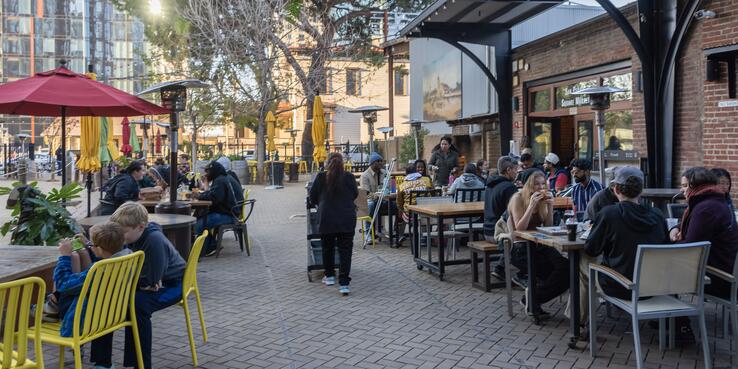On the whole, San José weathered the changes caused by the pandemic reasonably well, but downtown, where sales tax revenue dropped significantly, did not fare well. The City Manager's Office reports that the decline in collections from 2020 to 2021 within the Downtown Growth Area was 38.5%, and recovery has been slow. The Kastle Workplace Occupancy Barometer indicates that the number of people back in the office compared with the pre-pandemic number remains startlingly low at 39.5%, which puts San José dead last among the ten metro areas covered by Kastle. A return to pre-pandemic office occupancy rates is unlikely anytime soon, if ever.
As our large Bay Area cities recover from the COVID-19 pandemic, SPUR is working on unique policy solutions for the downtowns of San José, San Francisco, and Oakland to advance prosperity, equity, and sustainability.
In San José, we envision a downtown transformed into a thriving hub that demands attention and admiration — one in which city leaders have accounted for various potential return-to-work scenarios by adopting strategies that support the continued development of a central social district.
Strategy 1: Maximize San José State University’s integration with downtown.
San José State University, with more than 35,000 students and 4,000 staff on an 88-acre campus, is the largest university in a California downtown. Its location on the eastern edge of San José’s downtown core offers the city an opportunity to create a university district that connects downtown with neighborhoods to the west. Plans to build 1,000 units of student, faculty, and staff housing off of San Carlos Street could make that corridor the main off-campus street for students (much like Telegraph Avenue in Berkeley). City leaders should prioritize and facilitate that residential development. SPUR supports efforts to add thousands of new housing units on and off campus.
Strategy 2: Analyze the viability of multiple forms of adaptive reuse of vacant office space.
Many cities are considering or already pursuing conversion of offices to housing. That strategy could help repopulate San José’s downtown. But housing is not the only conversion option. City leaders should explore other potential uses of vacant office space.
Strategy 3: Rethink other uses for ground-floor retail.
City leaders should envision retail that is intermingled with social and community services, that brings crafts and making to the forefront, and that creates an environment more reflective of the tastes and lifestyles of younger generations. They should review zoning ordinances and infrastructure programs to ensure that shifting land use trends are adequately accommodated for long-term community benefit. Work-from-home and live-work units can be flexibly employed to meet the current and future needs of downtown and to contribute to an increasingly thriving community.
Strategy 4: Double down on a placemaking approach that emphasizes civic infrastructure, parks, arts, and cultural amenities.
During the pandemic, the city’s temporary but ongoing Al Fresco Initiative streamlined permitting for outdoor dining spaces, leading to lessons that could be applied to permitting for new brick-and-mortar shops. The initiative showed that vibrant public spaces are magnets for people and an effective tool for revitalizing local businesses and boosting the economy. Similar placemaking initiatives, such as public art installations and outdoor musical events, can facilitate social interaction, strengthen community ties, and promote well-being. City leaders should pursue an approach that puts public spaces to use and that streamlines permitting on private property.
Strategy 5: Provide the support small businesses need to bring vibrancy downtown.
City leaders can support small businesses to attract patrons in three ways:
- Adopt policies that foster economic development and innovation hubs, incubators, and accelerators that provide small business resources.
- Provide grants, low-interest loans, or tax incentives specifically designed to support small businesses’ recovery and growth and streamline application processes for this financial assistance.
- Review regulations, making them more business-friendly without compromising public safety or consumer protection.
These strategies will give the tens of thousands of San Joséans working from home reasons to spend time downtown.
Once San Joséans accept that downtown will likely never return to the way it was before the pandemic, they can plan for what they hope it will become. Now is the time to assess what worked during the pandemic and to adapt to post-pandemic realities in a way that allows downtown to be reinvigorated.
For decades, San José has focused on developing downtown as a jobs center. However, given low demand for office space, it’s time to reimagine downtown as a place for socializing, residential living, and entertainment-focused activity.
